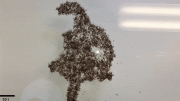
The invasive red fire ant has established a presence in Europe, with colonies found in Sicily, Italy. This aggressive species, posing ecological and health threats, could potentially colonize 7% of Europe. Researchers stress the urgency for rapid response and widespread monitoring. Credit: Jesse Rorabaugh
The study confirmed that the red fire ant, considered one of the most invasive species in the world, and the 5th most costly to combat, has been introduced and established in Europe.
A study published in the prestigious journal Current Biology, led by the Institute of Evolutionary Biology (IBE), a joint center of the Spanish National Research Council (CSIC) and the Pompeu Fabra University (UPF), has identified 88 red fire ant nests spread over 5 hectares near the city of Syracuse, in Sicily, Italy. These are invasive colonies that could have come from China or the United States, where it is also an invasive species, according to the study’s genetic analyses. This work, led by Roger Vila, a scientist at the IBE, with Mattia Menchetti as its first author, an INPhINIT ”la Caixa” pre-doctoral researcher at the same institute, has had the participation of CREAF, the University of Parma, and the University of Catania.
The ecological models introduced in the study show alarming predictions about the colonization potential of this ant in Europe, which could be facilitated by climate change.
The Red Fire Ant Is One of the Major Invasive Species
The red fire ant, Solenopsis invicta, is an invasive species from South America that has had a major impact on ecosystems, agriculture, and human health in several countries worldwide. Its sting is painful and irritating and can cause pustules and allergic reactions, possibly leading to anaphylactic shock.
In less than a century, this ant has spread in much of the United States, Mexico, the Caribbean, China, Taiwan, and Australia, and has been eradicated only in New Zealand. Its presence in the United States has caused an estimated loss of nearly six billion euros per year, while countries like Australia allocate millions to its eradication, with little success.
The Arrival of the Red Fire Ant in Italy
Before this study, S. invicta had been found occasionally in imported products in Spain, Finland, and the Netherlands, but its establishment on the continent had never been confirmed.
Using genetic analyses, the study concluded that the population detected probably originated in China or the United States, but the route of entry is unknown. The colonies are located in a suburban area of the city of Syracuse, Sicily, comprising an estuary and a natural park. It is an isolated area, so it is unlikely that it was the first point of entry to the island. The team concluded that the entry point must have been a transit area with human activity, such as the commercial port of the city of Syracuse. Indeed, analyses of the wind direction indicate that some flying queen ants could have arrived from the northwest, where the port of Syracuse is located and where the team has recommended monitoring for this invasive species.
Potential European Invasion by the Red Fire Ant
Using distribution models developed in collaboration with CREAF, under current environmental conditions, the study concluded that this invasive species could potentially be established in approximately 7% of the continent.
The results suggest that half of the urban areas in Europe would be climatically suitable for the establishment of this invasive species. Large cities such as Barcelona, Rome, London, or Paris could be considerably affected by this invasive species, which can impact people’s lifestyles due to its abundance and aggressiveness.
Mediterranean coastal cities, highly connected by seaports, are the most suitable to S. invicta, which could facilitate its spread. Considering climate change predictions, the scenario could become much worse, as the species could potentially expand to other parts of Europe.
“Coordinated efforts for early detection and rapid response in the region are essential to successfully manage this new threat, before it spreads uncontrollably,” warns Roger Vila, principal investigator at the IBE’s group of Butterfly Diversity and Evolution, who led the study.
“The public could play a key role in the detection of S. invicta, considering that it is frequently found in urban and adjacent areas. It is possible to detect this ants due to its painful stings and the characteristic mounds of their nests, although confirmation of an expert is required,” explains Mattia Menchetti, an INPhINIT ”la Caixa” pre-doctoral researcher at IBE and the study’s first author.
Given the dispersal capacity of this invasive species and the presumed existence of an unknown initial point of entry, the team recommends that monitoring be extended over a larger geographical area.
For more on this research, see Invasive Red Fire Ants Confirmed in Europe for the First Time.
Reference: “The fire ant Solenopsis invicta is established in Europe” by Mattia Menchetti, Enrico Schifani, Antonio Alicata, Laura Cardador, Elisabetta Sbrega, Eric Toro-Delgado and Roger Vila, 11 September 2023, Current Biology.
DOI: 10.1016/j.cub.2023.07.036
This study received support from the ”la Caixa” Foundation, among other organizations.









The route of entry is unknown??? Try imported potted plants.